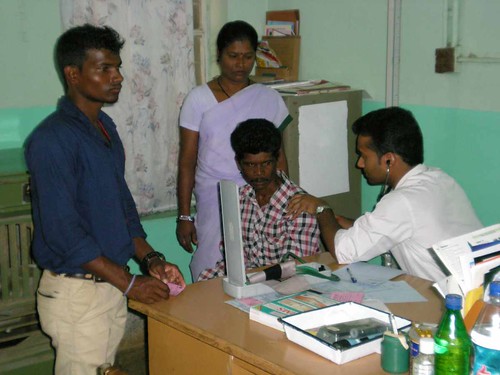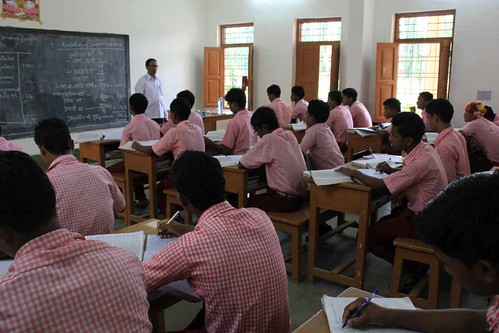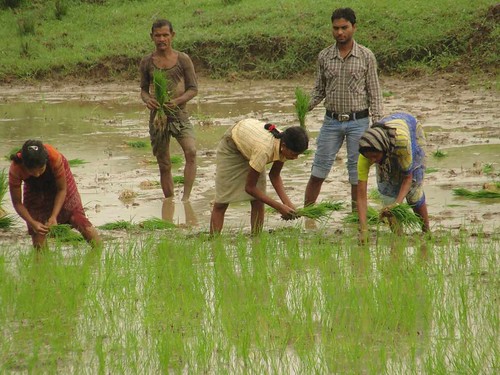Ramakrishna Mission’s Work for the Tribal People
ONE OF THE REVOLUTIONARY teachings of Sri Ramakrishna was ‘Serve the jiva as Shiva’. Whenever an opportunity presented itself, he was ready to serve people. He served many suffering, famine-stricken people with food and clothing at a village called Deoghar when he was on his way to Benares and Vrindavan. His famous disciple, Swami Vivekananda, would feed the poor tribal (Santhal) labourers engaged in construction work at Belur Math with such joy that he would shed tears, remarking, ‘I have today fed the true Narayanas.’ This grand legacy left by the founders of the Ramakrishna Mission later found expression in its various beneficial activities during disasters like famine, flood, fire and riot, and also in combating ills like poverty, illiteracy, and different kinds of suffering. One such activity is its work among the tribal community of India.

Documentary on Ramakrishna Mission, Narottamnagar, Arunachal Pradesh

In India the tribal people generally live in secluded places — forests and hills, away from the advanced sections of society. In Article 46 of the Indian Constitution, we find ‘Scheduled Tribes’ mentioned but not defined. A pre-Christian edict of Ashoka reads, ‘Upon the forest tribes…the Emperor has compassion.’ It is thus evident that the tribal communities in India have lived in peace with the rest of the society for the last two-thousand years. It was only when the British colonists started tampering with the tribal society in the third quarter of the eighteenth century that the problems of Indian tribal community began.
The British enacted the Scheduled Tracts Act in 1874, the Backward Tracts Act in 1919, and the Excluded Area Act in 1935, all of which were politically motivated, meant to segregate the tribal people from the main-stream society. According to the 1981 census, tribal people in India numbered more than 5 crores (5,16,28,638) out of a total population of 69 crores. They lived in large numbers in Madhya Pradesh, Orissa, Bihar, Maharashtra, Gujarat, and Rajasthan. Among them 89.39% professed some branch of Hinduism, 5.35% Christianity, and the rest belonged to 52 clannish religions. We shall discuss now the contribution made by the Ramakrishna Mission in the field of tribal welfare in India.

The Beginning
The Ramakrishna Mission started its work in Meghalaya way back in the 1920s. Its Cherrapunji centre was officially affiliated in 1931. Swami Prabhananda (Ketaki Maharaj) started primary schools at Shella, Cherrapunji, and Shillong. He was ably assisted by younger swamis in imparting the man-making education advocated by Swami Vivekananda. He introduced homeopathic and biochemical medicines, and also improved methods of potato cultivation, which was their staple food. In the teaching of the alphabets, an innovation was made — music and poetry were introduced. Thus by singing a few couplets, the students could master all the fifty odd alphabets.
Swami Chandikananda, who had a flair for singing and composing, could write quite a number of songs in the Khasi dialect, the themes of which were the life and message of Sri Ramakrishna, Holy Mother, and Swami Vivekananda. He has, in a way, become inextricably associated with the Khasi people through these songs.
In this way, through these educational institutions, their pride in their own tribal culture (dress, decoration, dance, festivals, etc.) silently started growing. The folk-dances of Cherrapunji and other places began to come into prominence, especially when they were taken up by the educated youths who were getting modern education in the Ramakrishna Mission schools. This helped the Khasis to some extent from being swept off their feet by the onslaught of the Western culture. These educated Khasi young men later started a seng khasi (Pure Khasi) movement, which works for the preservation of the best values of life in their tradition, along with spreading modern education. The liberal concept of respect for all religions practised by the Mission has attracted students of many sects of Christianity, which were engaged in conversion. Thus the Catholics and Protestants of Khasi, Garo, Mizo and Naga, and also the Kachari and Jaintia groups, started joining our school along with Hindu students. It thus became a laboratory of the harmony of religions where all respected the teachings of Sri Ramakrishna and Vivekananda.
On the anniversary of Sri Ramakrishna, a large procession of our students (mostly non-Hindus) and the public passes through the streets of Cherrapunji singing the glories of Sri Ramakrishna. Our school hostel in Cherrapunji has a prayer hall where pictures of Christ and Buddha are kept on the altar along with those of Sri Ramakrishna, Holy Mother Sri Sarada Devi, and Swami Vivekananda. Even local people join in our prayers.
Khasi Culture
Some of the ethical codes of the Khasis are worth emulating. One among them is non-stealing, asteya, as it is called by Patanjali in his Yoga Sétras. No Khasi would steal other’s things. If any Khasi inadvertently drops or leaves a kerchief, a hat, or a money-bag, or, for that matter, anything, on the road or elsewhere, all that he has to do is walk back the same path and find his article lying where it was dropped. No one would even touch an object that was not his or hers. I have seen boys and girls leaving their umbrellas, instrument boxes containing small cash, etc. in their classrooms, but no one will take other’s belongings.
As the schools were upgraded up to class VIII in the late 1930s, a great need was felt for opening a high school at Cherrapunji. It was strange that the foreign missionaries, who were running numerous schools in Meghalaya for almost a century, i.e. from 1840 onwards, had never opened a high school till then. When the Ramakrishna Mission earnestly went ahead to open one at Cherrapunji, the missionaries too tried to open similar ones and compete. But the D.P.I., an Englishman, refused permission, quoting the existing regulations against opening high schools in close proximity to the ones already functioning, unless it was filled to capacity. Thus, this first ever high school of South Meghalaya, having 45 primary and middle schools as feeders, all under the Ramakrishna Mission, has become a pioneer in the secondary school education of the Khasis.
The number of students in this school went beyond 500 in the 1960’s, with an equal number of boys and girls, thanks to the unprecedented encouragement the girls received from their mothers. The Khasis perhaps are the only matriarchal society in India besides the Nairs of Kerala. However, more power is wielded by women in Khasi society than in Kerala. For example, once when I visited one of our primary schools, I found the number of benches in the classrooms too few for the whole class. The compromise arrangement, in which a part of the students would sit on the floor, was put into effect with boys sitting on the floor and the girls occupying the benches. The boys did not complain at all, because they were brought up like that. For instance, a 5 or 6-year-old girl in a family would be given some money by the mother, which she always carried in a small bag hanging from her shoulder. Her brother did not get this privilege, with the result that the superiority of the girl was impressed on him even from that young age. Further, it was the girl who inherited the family property from the mother; children took the surname of their mother and not of their father; and the bridegroom lived with his in-laws after marriage.
For those of us hailing as we did from patriarchal families, it took a long time to learn this new sociological situation in Meghalaya, in which a Khasi girl is considered the way we consider a boy in the plains in matters of taking decision and work-efficiency. In this connection I remember a funny incident. A headmaster of one of our middle schools was influenced by some of his Khasi friends who had been educated in Calcutta. He had joined their secret society for establishing a patriarchy in place of the existing matriarchy in Khasi society. Once, when he returned home at dead of night after attending a secret meeting of the society, his wife, who had somehow come to know of the fact, refused permission to her husband to enter the house. At last he had to apologize for attempting such a move and promised her never to repeat it again. Only then did she admit him into the house.
The tribal people in general appreciate men of strong will who take bold, though sometimes harsh, decisions. I have noticed them appreciating one of our swamis as ‘a tiger’ (sakaiah in Mizo language) because of his strong will and bold decisions. A Governor or a Deputy Commissioner would be praised only if he is a strong disciplinarian along with being benevolent, not otherwise.
The Khasis believe themselves to be the descendants of a Burmese Queen, hence their matriarchy. Physically hardy, mentally quite intelligent, and artistically endowed with sweet voices and a sense of rhythm, they are good singers and dancers. Some of them are hereditary worshippers of a snake-god called U-Thlen. These worshippers are called ‘Nongshuno’. This worship, they believe, enables them to get good crops, health, etc. But the difficulty lies in that the U-Thlen is to be propitiated annually with human blood, which is not possible nowadays. Hence, to get exonerated from the hereditary responsibility of U-Thlen worship, one has to throw all one’s belongings into the fire of his own burning house. Even the educated youths of the Ramakrishna Mission schools believe that a ‘nongshuno’ cannot be killed by any physical means. Even Christians continue their hereditary U-Thlen worship.
Similar is their idea of not using pipe-water. When the Ramakrishna Mission constructed a water reservoir and offered to connect pipelines to their houses free of charge, the conservative Khasis refused. It took several years for them to change their attitude.
Expansion of the Tribal Work
Since 1922, alongside this work with the people of Khasi, Garo, and Jaintia hills, Ramakrishna Mission has been working for the uplift of scheduled castes and tribes at Thrissur and Kalady in Kerala, Manasadwip in West Bengal, Puri and Bhuvaneswar in Orissa, and Anckal and the B.R. Hills area in Karnataka.
Around 1966, a new field for the Mission’s tribal service opened up when an invitation came from the Government of India to start centres in Arunachal Pradesh on the borders of China and Burma, some 600 kilometres away from Guwahati, the capital city of Assam. The choice of the Government fell on the Ramakrishna Mission because of its liberal principles of (1) non-proselytization, (2) non-sectarianism, i.e. treatment of all people as equal, irrespective of religion, caste, sect, or sex, and (3) national outlook featuring a synthesis of science and religion on the basis of Vedanta, and thus imparting a most modern scientific and technological education along with the values of life which encourage all to be good and do good. Between 1966 and 1979, in that inaccessible place Ramakrishna Mission started three centers, viz. at Along, Narottam Nagar, and Itanagar, the first two being educational, and the third, a hospital centre. I remember the hesitation of the Gallong tribal people at first to send their wards to our hostel and school. Later they did gladly send their children. If the parents wanted one of their children studying in our school to visit home, the elder son from the family would come and say, ‘Sir, please allow my brother to visit the village and keep me instead in his place until he returns.’ This shows their ignorance as well as their simplicity. These Arunachalis — about 50 tribes in all, with a population of 7 lakhs — are hardy, fearless, and daring. They live peacefully amidst the snakes, tigers, elephants, and oxen, which abound in the area.
At last the general Arunachali tribes welcomed the Ramakrishna Mission school at Along. For the first time they saw their children getting the best English medium education, with Hindi, Sanskrit, and science too, without any fear of conversion. On the contrary, the Ramakrishna Mission encouraged their traditional religion and culture through the composition of songs in their dialects of Gallong, Mynyong, etc. In this connection, the Ramakrishna Mission, for the first time, started publication of literature on Indian culture in the Adi dialect. Some thirteen titles have since come out and the publication work is continuing. These books have become quite popular, especially among students, who feel proud about everything in their culture. Thus they have succeeded in shedding the inferiority complex so deeply rooted in the tribal psyche. This accounts for the relatively quicker progress of the Arunachali tribal people than others in the northeast. An incident will illustrate this point. One of our girl students went to study in a college at Shillong. Her Christian friends there went on pressing her to change her traditional name to a Western Christian name, and her traditional religion to Christianity. Though a single girl pitted against the whole class, she did not budge an inch throughout the period of 2 years of her stay there, after which she returned home and settled down marrying a doctor of her own tribe.
This faith in themselves has made the Arunachalis succeed in assimilating much good from both the Indian and the Western cultures without being swept away by a mere cheap imitation of the West, as has happened with the tribes of Nagaland and Mizoram. You can meet Arunachali students in the metropolises of both South and North India carrying on their studies and living happily with their friends in the plains because of their knowledge of Hindi and English. They are also learning Hindustani and Karnatic music, the different dance forms of Bharata-natyam and Kathak, and also tabla, sitar, and other musical instruments. One is astounded at the national sentiments the Arunachalis imbibe through their education in the Ramakrishna Mission schools. In these schools, the entire student community repeats during their morning assembly the following ‘National Integration Oath’ of five sentences of Swami Vivekananda:
- I am an Indian.
- Every Indian is my brother.
- India is my life.
- India is my heaven.
- In India’s welfare lies my welfare too.
We got the feedback of the effect of this daily oath when I was in Calcutta on an educational tour of our girl-students of class IX. One day, our eleven girls were waiting for a bus in Calcutta when some Bengalis, noticing their uncommon features, remarked, ‘They are Chinese.’ Immediately one of our girls loudly protested: ‘We are not Chinese. We are Indians. We are Arunachalis.’ Needless to say, the Bengalis were silenced by this vehement reply, and also perhaps due to their becoming aware of their own colossal ignorance.
Social Reforms
Swamiji often said that social reforms follow in the wake of good education. This has happened with the Arunachalis. Students from practically all the States of India study in our schools spread throughout the country. They mix with each other like members of a big family and learn each other’s manners and customs. Thus the Arunachalis have adopted the Rakhi and Holi festivals, and also Hindi language and songs. Even as a child one of our tribal girls studying in class IX had been married to another child. Her in-laws sent a court notice to her saying that as she was sufficiently grown up now, she should give up her studies and join her husband’s home. Noticing this promising girl in dire distress, I was worried. But to my astonishment, in the village court she declared before the Deputy Commissioner that she was not bound by the Tribal Child Marriage Laws, which had been outlawed by our Constitution. She never looked back afterwards until she completed her MBBS and was appointed as a doctor in the Government Hospital in her own district. Similarly, many young people have given up drinking and even smoking in order to scale greater heights of interaction with the mainstream society brought about by the Ramakrishna Mission education.
Another consequence of good education was the disappearance of ignorance regarding modern medicine. When we established the first full-fledged hospital in the capital of Arunachal Pradesh, Itanagar, the Nishi and Apatani tribal people were not very impressed. But slowly they were, as our sincere doctors picked up patients from roadside villages and brought them back to health. The following incident is interesting to note in this connection.
A tribal patient near our hospital, dehydrated due to dysentery, was almost unconscious and was thought dead by the neighbours. He was then picked up by our doctors and put on intravenous fluid drip for a full night. In the morning he started improving and was quickly back to normal. The joy of the tribal people knew no bounds. They said: ‘Here you see a dead man being brought to life by Mission’s doctors! Why should it not be so? Even one injection, as we have seen, is so effective, and here they have injected him throughout the night!’
Once, when dysentery became an epidemic in a village, I visited it. The people, we heard from the Government health officers, were demoralized at the virulent incidence of the disease and would not listen to the advice of basic hygiene and medical treatment. But when I announced that I would eradicate the epidemic if they followed our regulations of using and drinking only boiled water etc., they immediately agreed to obey. When I lifted two dehydrated patients into our medical van to be treated at the District Hospital, they agreed to go on condition that they both be repatriated to their village, dead or alive, by our own vehicle. I could return only one case alive, as the other case did not respond to intravenous fluid treatment. But the villagers were so happy at my having kept my word.
Thus, Ramakrishna Mission’s work among the tribal people of Arunachal has been progressing from strength to strength. It is bringing these neglected people into the mainstream of national life through character-building education and imparting of values like truth, purity, faith in one’s own inherent powers and in God, and also selfless service to society. One can hear Arunachali boys and girls saying with pride that they study in the ‘Mission’ school, ‘Mission’ meaning ‘Ramakrishna Mission’. In today’s Arunachal Pradesh, one can see among the Ministers, MPs, MLAs, and middle school teachers, products of Ramakrishna Mission schools rendering valuable service to their community.
New Work in Chhattisgarh
With this valuable experience, the Ramakrishna Mission now ventured into a new field of tribal work. In the Bastar district of Madhya Pradesh, Abujhmarh is a hilly tract spread over an area of 25,000 square kilometres. Twenty-thousand people of the ‘Madhia’ tribe have been dwelling there for the past 800 years, totally unaware of civilization. ‘Abujh’ means unknown, and ‘marh’ means hillocks. When the government of Madhya Pradesh felt helpless in trying to reach these nomadic groups through their government machinery, they requested the Ramakrishna Mission to take up this challenging work. In 1985 the Mission accepted the challenge. First of all, even to reach the Madhia people’s dwellings and contact them was a task for which one had to walk 50 to 60 kilometres, sometimes crawling on all fours. In the beginning these people would not allow us to open any of our service centres. ‘You better go away and leave us alone’, was their curt reply. We had to cajole them by promising to feed their children four times a day as well as provide them schooling. That made them yield.
Documentary on Ramakrishna Mission, Narainpur, Chattisgarh
Thus we started primary boarding schools where the boys and girls are being provided proper clothing and regular food along with lessons. To each school is attached a ‘Fair Price Shop’, selling basic commodities like salt, rice, dal, kerosene oil, etc. to the tribal people. It also purchases in turn their minor forest products such as honey and broomsticks. Also attached to the school is a medical helper. He administers simple medicines prescribed by the doctors visiting the tribal people every week through the mobile medical service. There is an agriculture assistant attached to every school teaching improved agricultural, horticultural, and kitchen gardening methods to the students as well as to the villagers. For this purpose, each school has a 15-acre plot of land attached to it. As the villagers, who were earlier being cheated in the weekly bazaars held in the nearby plains, got the right price for their products (Rs. 28 for a kilogram of honey in place of Rs. 10, and Rs. 6 for a broomstick instead of Rs. 1), their purchasing power grew. They started purchasing bicycles in larger and larger numbers as the best means of transport. Those who had been going practically naked till then, now started wearing shirts and pants, cholis and sarees. It was earlier alleged that they were averse to clothes, but it has been proved that it was their poverty that kept them in nakedness.
As usual, the ignorance of the Madhias made them vulnerable to exploitation by forest officers on one side, and police on the other. Hence they were very afraid of the officers in ‘Khaki’. When the swamis of the Ramakrishna Mission were found selflessly helping and serving them, the news went round that these ‘officers’ were sannyásins. Selflessness and service endeared the swamis to the Madhias so much that later on whenever there was a conflict of ideas between the swamis and the Naxalites, who were hiding and training in those very areas where the Ramakrishna Mission schools were situated, the Naxalites had to yield to the work schemes of the Ramakrishna Mission. For example, when the Ramakrishna Mission was putting up a culvert across a rivulet to make a road to a village, the Naxalites stopped the work. When we reported this to the Madhias of the beneficiary village, they immediately went to the Naxalites and asked them not to interfere with the construction of the bridge which was for their benefit.
Once, at night, another Swami and I went into a Naxalite camp near our village just to meet the leader. It was pitch dark at about 7 p.m. I went past two sentries with guns after giving my credentials to them. Then passing through a gathering of Madhias, which was being addressed around a campfire by four gun-totting Naxalites, two of whom were women, I reached their leader seated behind another gunman under a shed. During the course of our conversation, the leader admitted that he admired our services to the tribal people, and hence would not interfere with our work. Only he warned against any of our men informing the government of their movements. The next day’s newspapers announced that a new and dangerous group of 7 or 8 Naxalites with two women had entered the Madhia area. I was perhaps the first to meet them face to face, in their own den.
Our schools in Abujhmarh (six primary, three middle, one high, and one higher secondary) came into existence in quick succession. It gives them the best education, which is not only academic but also vocational, including training in carpentry, agriculture, poultry, fishery, fruit gardening, tailoring, printing, typing, drawing, painting, etc. It also provides them training in Hindustani music, both vocal and instrumental, and also in sports like football, volleyball, kho-kho, gymnastics, and table tennis. Within a short span of three years, the Ramakrishna Mission school at Narainpur stood second in football and gymnastics at the state level. The school’s band is the best in the state and has taken part in the Republic Day Parade at Delhi. Due to the comprehensive education imparted by the Ramakrishna Mission schools, the Madhya Pradesh government has declared it to be a role model to be followed by all the other tribal schools in the state. Within the short eleven years of Ramakrishna Mission’s work among this Madhia tribe, the tribal students of our schools, first time in their tribe’s history, were seen studying advanced courses in the science, engineering, and medical colleges of Madhya Pradesh. In five villages in the interior of Abujhmarh, five stop-dams across the rivulets have been constructed, and the large reservoirs of water have made these villages self-sufficient in drinking water and water for agriculture. This has become a boon for pisciculture and teak plantations as well. Even tigers, cheetahs, and bears reap the benefit of these reservoirs. Thus the Madhias are on the path of progress through education and economic well-being. They may even lead other tribal communities in India before long.
Bihar-Jharkhand Tribal Work
Finally, let us briefly look at the development of the tribal people of Jharkhand through the efforts of the Ramakrishna Mission ‘Divyayan’ at Morabadi, Ranchi. It is an institution that strives to educate and elevate the illiterate tribal people in the rural areas of Jharkhand. In a unique experiment under the Ramakrishna Mission, 6 batches of 250 rural tribal people are taken every year and trained in improved methods of agriculture, horticulture, kitchen gardening, dairy work, poultry raising, bee-keeping, sericulture, maintenance of agricultural pumps and implements, etc. Besides these, they are also trained in physical exercise for good health. They are taught singing of devotional songs. They also learn, through daily reading, the life-giving message of Swami Vivekananda — the message of divinity and equality of man, and of dedicated service, through which grows one’s own as well as socitey’s wealth and strength. These trainees, after they return to their rural areas, spread their new knowledge of all-round development through selfless service to others by running night schools to eradicate illiteracy. Above all, they spread the message of Swami Vivekananda — the message that Indians should arise and awake to their innate spiritual strength, and through that, build a healthy, wealthy, and wise nation. A new awakening is seen among the tribal people of Ranchi who have made the Krishi Vigyan Kendra at Divyayan ‘one of the best centres engaged in rural and tribal development in the country, and best in Jharkhand-Bihar belt’.
The Ramakrishna Mission has thus been serving the tribal people in India for nearly 90 years. In the process, it has gathered rich experience with which it would serve them better in this 21st century.






)

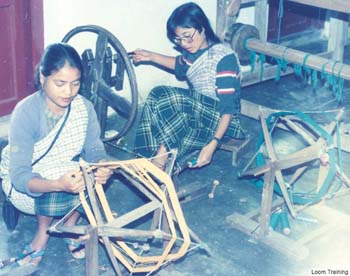


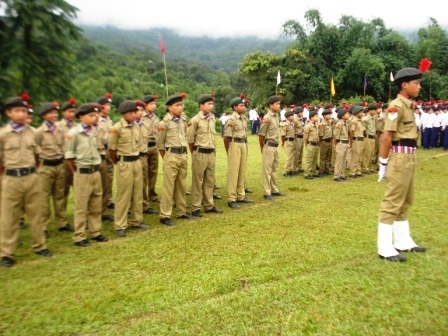
)
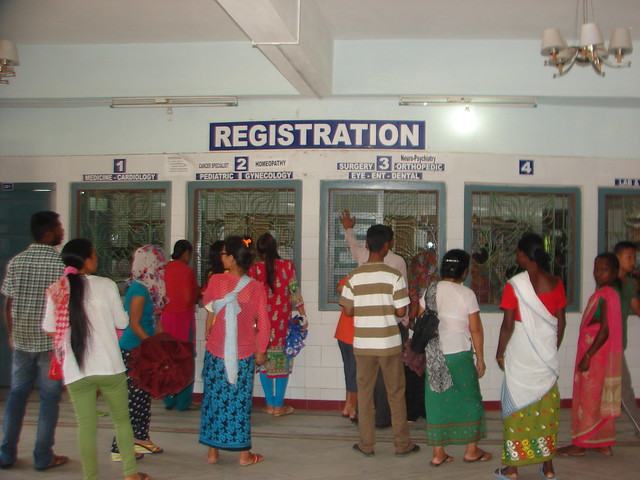

)

